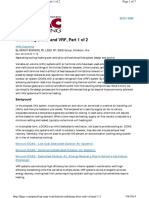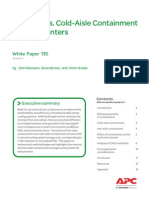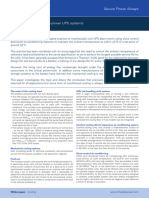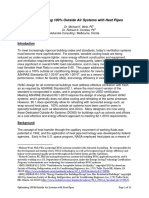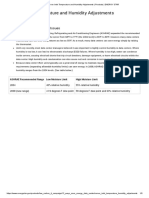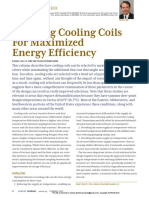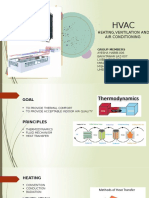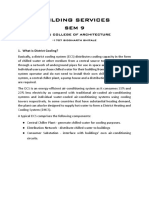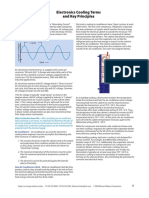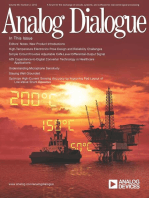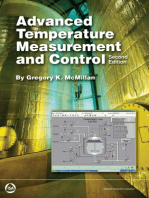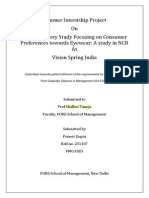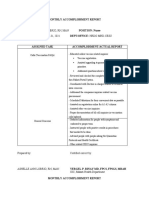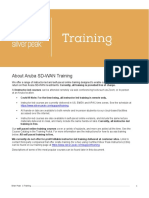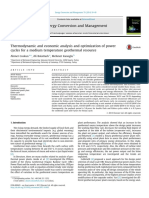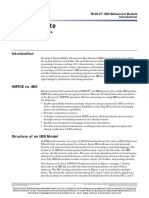Article Vav Coils
Article Vav Coils
Uploaded by
fatima el karmiCopyright:
Available Formats
Article Vav Coils
Article Vav Coils
Uploaded by
fatima el karmiCopyright
Available Formats
Share this document
Did you find this document useful?
Is this content inappropriate?
Copyright:
Available Formats
Article Vav Coils
Article Vav Coils
Uploaded by
fatima el karmiCopyright:
Available Formats
COLUMN HVAC APPLICATIONS
This article was published in ASHRAE Journal, January 2014. Copyright 2014 ASHRAE. Reprinted here by permission
from ASHRAE at www.krueger-hvac.com. This article may not be copied nor distributed in either paper or digital form
by other parties without ASHRAE’s permission. For more information about ASHRAE, visit www.ashrae.org.
Dan Int-Hout
VAV Coils, Fan Coil Devices
BY DAN INT-HOUT, FELLOW ASHRAE
Proper design and specification of VAV terminals or fan coils can be quite chal-
lenging as there are many items that must be considered, including perimeter
zone needs, motor types, discharge air temperatures, energy consumption, as
well as compliance with local codes and current standards. One item in particu-
lar seems to make the selection process that much more difficult—the coils.
They are specified as a means to heat or cool conditioned air, using either hot
or cold water, electricity, or in some cases, direct expansion (DX) coils. Without
understanding the parameters for selection, the limitations of the coils and their
impact on the air-distribution system, engineers will continue to run the risk of
developing faulty designs and problematic installations.
When a heating coil is specified on VAV terminal units, above the room (90°F [32°C] in a 75°F [24°C] room) will
it is typically to deliver individual room controlled heat likely result in significant unwanted air temperature
to perimeter zones and offset skin load heating demands. stratification, likely exceeding the ASHRAE comfort
Single-duct terminals normally reheat cooled primary standard’s (55-2013 is the latest) vertical temperature
air to offset perimeter heating requirements. This may stratification limits. Furthermore, ASHRAE Standard
waste energy, especially when the same air handler is 62.1 (ventilation) requires increased outside air when
using chilled air for interior zones, which require year- heating from the ceiling if this rule is not followed
round cooling. However, ASHRAE Standard 90.1-2013 (Standard 62.1-2013).
now allows up to 50% of the design maximum cooling This is because hot air tends to stay at the ceiling and
airflow in a VAV terminal to be heated, provided that may “short-circuit” directly back to the room exhaust
the minimum is set at 20% of the cooling maximum and without mixing in the room. Indeed, using the ASHRAE
that the discharge temperature is limited while heating Standard 129 test procedure for air change effectiveness
airflow is varied. Fan-powered terminals and ducted fan measured mixing effectiveness values as low as 20%
coils use heated plenum air to offset perimeter loads. (or lower) have been observed in laboratory tests when
Both fan terminals and fan coils require some energy the supply to room differential exceeds 15°F (27°C).
to run the fans, so the use of fan-powered units is not Calculations will show that in most cases, 85°F (29°C)
without some penalties. In mild climates, the tradeoff air will handle a typical winter design perimeter load at
between the equipment’s first cost and operating cost 1 cfm/ft2 (5 L/s·m2) air supply rate (the airflow rate likely
may suggest that a single duct reheat unit is the most required for both good ventilation mixing and comfort).
economical choice. The use of electronically commu- The maximum design discharge temperature should
tated motors (ECM) can significantly reduce fan energy be no more than 120°F (48°C). This is the limit for elec-
consumption in both fan-powered VAV and fan coils. tric heater units as set by the National Electrical Code.
Varying the airflow rate to the minimum required can Insulation adhesives are also typically designed around
make both fan terminals and fan coils very efficient, this expected air temperature. If fan-powered units
compared to constant volume non-ECM applications.
The ASHRAE Handbook—Fundamentals states that dis- Dan Int-Hout is a chief engineer at Krueger in Richardson, Texas. He is a member of
charging air at a temperature greater than 15°F (27°C) SSPC 55, SPC 129 and consultant to SSPC 62.1.
58 ASHRAE JOURNAL ashrae.org JAN UARY 2014
COLUMN HVAC APPLICATIONS
have a water coil located on the plenum inlet, caution FIGURE 1 Standard 62.1 rule on overhead heating.
must be used to not overheat the downstream fan motor.
To be safe, the coil discharge temperatures should be
limited to no more than 110°F (43°C). Engineers should
take special care to ensure that both occupied heating
and morning warm-up situations are covered in the
design with proper stages of electric heat or proportional
water coil valves.
The need to rapidly warm a space following a night by California code. Occupant complaints were frequent
setback has its own set of requirements. Air needs to be until VAV box minimums were lowered.
heated as rapidly as possible, with a maximum of mix- If ventilation minimums exceed the load or humid-
ing, without too much regard for occupant comfort. ity control requires a higher airflow, a slight amount of
While this requires both a high DT and a high airflow, the controlled reheat can prevent subcooling. It is important
physics of room air movement dictate that the hotter the that the room setpoint be maintained at the cooling set-
air temperature, the longer it will take to heat the room point, which for interior zones should be all the time.
for a given heat delivery rate due to stratification. The alternative is to reduce supply air temperature at the
On the surface, reheating cold primary air seems to air handler. This may result in other spaces that cannot
be a wasteful practice in terms of optimum utilization be cooled at design maximum airflows and may increase
of energy resources; however, there are many situations the space’s relative humidity.
where it is not only necessary, but also beneficial to do so. Controlling Humidity. Both humidity and ventila-
Providing Comfort with a Great Diversity of Loads. tion can be better controlled using reheat coils. When
When heating and cooling are required from a single the local humidity is too high, drier, cooler air can be
air-distribution system due to climate and building added, then slightly reheated to avoid subcooling. Fan
design factors, reheat is often an economical solution. coils may require both heating and cooling coils to be
Considering it is used in a few locations only part of the operated at the same time to control space tempera-
time, the energy penalty for reheat is minimal. tures and avoid sub-cooling. They also have to supply
Supplementing Baseboard Perimeter Heat. ventilation air. For this, a dedicated outdoor air system
Baseboard heating systems can be the most effective (DOAS) can be used to assist fan coils in dehumidifying
means by which to offset perimeter heating demand as well as ventilating a space. In the case of fan powered
loads. At times, however, peak heating demand loads VAV terminals, a sensible cooling coil on the induc-
may exceed the installed baseboard capacity and may tion inlet can offer increased flexibility and countless
require supplemental overhead heating. control options when coordinated with the ventilation
Maintaining Minimum Ventilation Rates. The ben- supply unit.
efit of an installed reheat coil in a non-perimeter zone
becomes apparent when the minimum ventilation rate Water Coil Selection
exceeds cooling demand. This happens when the quan- Most manufacturers provide software to accurately
tity of supply air to a space required to provide proper predict the performance of their products. In today’s
ventilation exceeds the quantity required to offset local environments, it is common to see lower heating inlet
heat sources, such as when the ratio of occupants to water temperatures as well as higher water temperatures
equipment (which requires little ventilation air) shifts in sensible cooling coil applications. It is recommended
toward occupants, as in conference rooms. As was that coil schedules be prepared using a program that
observed in the recent ASHRAE research study RP-1515, has inlet and installation effects dialed in, as meeting
modern computers and flat panel monitors give off such the required Btu/h and gpm in a specification is often
small amounts of heat that it resulted in interior systems impossible if mounting condition factors are not used in
going into reheat at minimum VAV settings. The system the calculations. Unlike many air handlers, fin spacing,
then maintained a heating setpoint several degrees circuiting, and tube spacing are fixed for most VAV fan
below the normal interior temperatures, as required box and fan coil water coils.
JAN UARY 2014 ashrae.org ASHRAE JOURNAL 59
COLUMN HVAC APPLICATIONS
With low loads being the norm, rather than the excep- 100% primary air with no downstream (or with an elec-
tion, minimum “capacity” is becoming a common prob- tric heating coil downstream). With lowered water tem-
lem. When water flow becomes too slow in a coil tube, it peratures requiring three- and four-row coils, this could
may become “laminar” and will make heat or cool dif- be a significant energy saving strategy.
ficult to control. This does not mean it will not transfer Parallel Fan Units. Most parallel units have the water
heat or cool, but rather we are unable to predict by how coil on the discharge (despite the obvious pressure pen-
much! Proportional water valves in conjunction with alty seen by the primary air handler); while some designs
modern thermostats work well to control space tempera- allow locating them on the plenum inlet. This latter loca-
tures, adjusting water flow to meet demand, even when tion makes the coil entering air temperature the same
flow may become non-turbulent. as the plenum air temperature. A parallel fan powered
With non-condensing (sensible) cooling water coils unit’s discharge air temperature is a mix of primary air,
appearing on both fan terminals and chilled ceiling typically at the minimum primary air flow rate, and ple-
induction units (“beams”), it is important that water coil num air at the fan airflow rate. This is the entering air
entering temperatures stay above the local dew point to temperature for a downstream coil. If the coil is on the
avoid condensation. Some building codes were recently induction port inlet, it is recommended that the heat-
modified to allow installation without a drain pan or to ing coil leaving air temperature always stay below the
allow a catch pan on sensible coils, rather than a drain maximum recommended for the motor, which is in the
pan. It is always a good idea to place a condensation sen- airstream.
sor on the inlet of a few sensible coils to alarm or close Leaving Water Temperature. Air handler cooling coils
water valves if the water temperature falls below ambi- are often selected on the basis of water coil DT. This tech-
ent dew points. nique, however, is not recommended for heating coils in
VAV boxes or fan coils, non-condensing boilers require a
Common Water Coil Issues high entering water (return water) temperature to avoid
Mixed Air Temperature. Mixed air temperature or “shocking” the system. Ensuring a high return water
unit leaving air temperature (the combination of pri- temperature is best achieved through three-way valves,
mary and induced air temperatures) is dependent on the secondary loops or other means, not through coil selec-
location of the coil. It is calculated differently for series tions. At part load, when the water valve is throttled, coil
or parallel fan powered VAV units: leaving water temperatures will always be less than rec-
Series Fan Units. For series fan units, heating coils are ommended by these boilers.
typically located on the discharge, where coil entering air Fluid Type. Three hot fluids are commonly used in
temperatures are based on the minimum primary and coil applications: water, ethylene and propylene glycol.
the induced airflow. The induced airflow is the fan cfm The use of glycol will significantly increase the mini-
less the minimum primary. With series flow units, the mum gpm required for turbulent flow and also reduces
heating coil leaving air temperature and the box leaving the specific heat of the fluid. Most programs compute
air are the same. If a sensible cooling coil is used on the a Reynolds number to determine the amount of turbu-
induction inlet, it must be included in the calculation of lence in the fluid in the tubes, which is usually desired
leaving air from the unit. If an ECM motor is provided, to be greater than 5,000. As the percentage of glycol
both coils, VAV (outside air) and induced air, may be var- increases, so too will the minimum gpm. Ethylene glycol
ied by the on-board processor to allow for a wide range is falling out of favor for environmental reasons, and
of operating conditions. propylene has a greater effect on minimum flow than
Locating the heating coil on the induction inlet is a ethylene.
possibility with an ECM fan motor, as it is able to deliver Coil Load vs. Room Load. A water coil is often selected
the same amount of air when the unit is essentially pres- based on a given Btu/h. There are two loads that can be
surized from the VAV inlet or when air is drawn through used for this calculation. One is the coil load, which is
the heating coil. Preliminary data suggests that an ECM based on the airflow rate and the supply to discharge
motor uses 40% more energy pushing (or pulling) air temperature differential. The other is the room load,
through a multiple row coil, compared to delivering which is the difference between the room and the unit
60 ASHRAE JOURNAL ashrae.org JAN UARY 2014
Advertisement formerly in this space.
COLUMN HVAC APPLICATIONS
discharge temperature; calculated by skin losses less Meeting ASHRAE Standard 62.1’s Ventilation Rate
internal loads. Often, it is not clear which is specified. Procedure requires control of discharge temperatures
Most programs assume the Btu/h load is the coil load. to avoid the required increases in ventilation rates when
heating from overhead. Proportional electric heat con-
Electric Heat Selection trols can provide this using either SCR devices or (quiet)
The electric heater provided on most single duct VAV solid state relays and time-proportional control, espe-
units is essentially a rated duct heater that is installed cially with a discharge temperature sensor as a part of
in an elongated single duct unit. This longer unit pro- the control logic.
vides for a developed airflow after the damper and a With fan boxes and fan coils with electric heat, especially
relatively uniform airflow across the coil elements. Fan ECM motor driven units, the fan’s minimum flow rate may
terminals and fan coils with electric heat typically place not be sufficient to permit electric heat operation, so there
the heater on the discharge of the unit. The heater has may be a minimum setting based on cfm/kW and DT. The
a safety switch that prevents the heater from engaging, allowable kW is a function of unit size, voltage, and phase
unless there is a minimum sensed velocity pressure in of the electric power supplied. With 480 V three-phase
the duct. While this is normally a velocity pressure sen- installations, a four-wire (three power leads plus a neutral
sor, in practice, it sometimes acts as a static pressure lead) is usually required for power hook-up for fan termi-
sensor. At low flows, there may be insufficient velocity nals. Fractional hp three-phase motors are typically not
or static pressure in the unit to “make” the contactor available, and most fan box designs connect one leg of the
in the flow switch. This may be due to probe location, 480 V three-phase to neutral to get a 277 VAC power tap for
damper position, low discharge static pressure or the motor. This means a 480 V three-wire connection (no
likely, a combination of all. neutral) to a fan box will require a very large transformer
for the motor or a dual power connection. Some non-fan
electric heat units are available with three-wire 480 con-
nections, but minimum kW’s may be limited. Again at low
flows there is both a minimum flow and a maximum kW
consideration.
Summary
When selecting electric, hot, or cold water coils, it is
important that all selection criteria be considered; not
only to ensure proper unit performance, but to also
Advertisement formerly in this space. properly distribute heated/cooled air into the space.
Amongst those considerations, one needs to also assure
that discharge temperatures and air quantities offer
both a comfortable space and provide for ventilation
mixing. This is supported by ASHRAE Standard 62.1
(ventilation) and Standard 55 (comfort), which require
proper selection of heating control, heating equip-
ment, and air delivery devices. We cannot lose sight of
Standard 90.1 (and Title 24 in California) either, as many
items outlined in this and other mentioned Standards
are required by most codes and are a prerequisite of the
current LEED requirements. It may be necessary for the
equipment supplier and control contractor to discuss
these issues with the design engineer before making
a final selection to ensure that everyone is making the
same assumptions.
62 ASHRAE JOURNAL ashrae.org JAN UARY 2014
You might also like
- Article Vav CoilsDocument5 pagesArticle Vav Coilsfatima el karmiNo ratings yet
- Vav Box Reheat Selection: Krueger KruegerDocument5 pagesVav Box Reheat Selection: Krueger KruegerKia KhosraviNo ratings yet
- Ashrae Journal On Reheat: Dan Int-HoutDocument7 pagesAshrae Journal On Reheat: Dan Int-HoutSergio GarroNo ratings yet
- Dual Duct Dual FanDocument2 pagesDual Duct Dual FansajuhereNo ratings yet
- Combining DOAS and VRF, Part 1 of 2Document8 pagesCombining DOAS and VRF, Part 1 of 2miniongskyNo ratings yet
- Reasons Engineers Are Choosing Dedicated OA SystemsDocument3 pagesReasons Engineers Are Choosing Dedicated OA SystemsADsupermanNo ratings yet
- Enews 30 03 090601Document4 pagesEnews 30 03 090601sajuhereNo ratings yet
- Vav ReheatDocument2 pagesVav ReheatallaadeenNo ratings yet
- Air Cooler Design SheikoDocument22 pagesAir Cooler Design Sheikojayhuacat7743100% (1)
- Effectively Design ACHE'sDocument22 pagesEffectively Design ACHE'sSeshu Bulusu100% (1)
- Combining DOAS and VRF, Part 1 of 2: HPAC EngineeringDocument7 pagesCombining DOAS and VRF, Part 1 of 2: HPAC EngineeringSmita SanjekarNo ratings yet
- Hot Vs Cold Aisle Containment For DCDocument13 pagesHot Vs Cold Aisle Containment For DCtommylaw100% (1)
- Using VAV Systems To Limit Humidity at Part LoadDocument5 pagesUsing VAV Systems To Limit Humidity at Part LoadTonyChuangNo ratings yet
- Air Cooled Heat ExchangersDocument7 pagesAir Cooled Heat ExchangersDigitalMastersTXNo ratings yet
- Ashrae Handbook Hvac ApplicationsDocument9 pagesAshrae Handbook Hvac Applicationsliza mae remoroza75% (4)
- 7 3 PDFDocument10 pages7 3 PDFrkibNo ratings yet
- Dissertation HvacDocument8 pagesDissertation HvacCheapPaperWritingServiceAnchorage100% (1)
- Advanced VAV GuideDocument7 pagesAdvanced VAV GuidedimchienNo ratings yet
- ASHRAE Journal - How To Design & Control Waterside Economizers-TaylorDocument7 pagesASHRAE Journal - How To Design & Control Waterside Economizers-TaylorsajuhereNo ratings yet
- Cooling Options UPSDocument3 pagesCooling Options UPSac4000No ratings yet
- Controlling Wrap Around Heat Pipe Systems White Paper 2015 1119Document10 pagesControlling Wrap Around Heat Pipe Systems White Paper 2015 1119brian mmec2020No ratings yet
- Evaluating Variable Air Volume (VAV) Packaged Rooftop Systems For Use in High Performance EnvironmentsDocument11 pagesEvaluating Variable Air Volume (VAV) Packaged Rooftop Systems For Use in High Performance Environmentsramon duldulaoNo ratings yet
- 100% Outdoor Air Dehumidification Methods: Technical Bulletin 16Document6 pages100% Outdoor Air Dehumidification Methods: Technical Bulletin 16Fatiga jrNo ratings yet
- Air Cooled Heat ExchangersDocument5 pagesAir Cooled Heat ExchangersRamuAlagappan0% (1)
- Module I - HvacDocument6 pagesModule I - Hvacamechmar5935No ratings yet
- Daikin VAV With Reheat Systems AppGuide AG31-021 LRDocument2 pagesDaikin VAV With Reheat Systems AppGuide AG31-021 LRMIGUELNo ratings yet
- Air Cooled Heat ExchangersDocument6 pagesAir Cooled Heat ExchangersIoana PopescuNo ratings yet
- Chilled Beams - European Technology Takling Hold in US - HPAC Engineering - 2010-1Document5 pagesChilled Beams - European Technology Takling Hold in US - HPAC Engineering - 2010-1Zuhair MasedNo ratings yet
- 12 Low Temperature Air Distribution PDFDocument2 pages12 Low Temperature Air Distribution PDFrkibNo ratings yet
- Saving Energy With Cooling TowersDocument6 pagesSaving Energy With Cooling TowersFernandoNo ratings yet
- Daikin Parallel Fan Powered VAV Systems AppGuide AG 31-018 LRDocument2 pagesDaikin Parallel Fan Powered VAV Systems AppGuide AG 31-018 LRSambhav TiwariNo ratings yet
- 3 Simple WaysDocument7 pages3 Simple WaysAruna Prasanna DewasurendraNo ratings yet
- Trane Chiller Plant Admapn014en - 0105Document4 pagesTrane Chiller Plant Admapn014en - 0105a_salehiNo ratings yet
- Designing Dedicated Outdoor Air SystemsDocument4 pagesDesigning Dedicated Outdoor Air Systemsrogel_ganaNo ratings yet
- VAV vs. VCDDocument7 pagesVAV vs. VCDomarsosa#747No ratings yet
- HPT Optimizing Outside Air With HPTDocument11 pagesHPT Optimizing Outside Air With HPTNGUYEN QUANGNo ratings yet
- Acb40-50 Metric UsDocument20 pagesAcb40-50 Metric UsGeovanni Sanchez TrejoNo ratings yet
- HVAC Cold Air DistributionDocument21 pagesHVAC Cold Air DistributionPhanhai KakaNo ratings yet
- Room Flow ProDocument12 pagesRoom Flow ProMuhammad Farooq SaeedNo ratings yet
- Server Inlet Temperature and Humidity Adjustments - Products - ENERGY STARDocument5 pagesServer Inlet Temperature and Humidity Adjustments - Products - ENERGY STARSergio GarciaNo ratings yet
- Price UfadDocument8 pagesPrice UfadbarelihbNo ratings yet
- 52-57 - Engineer's Notebook - Nall PDFDocument5 pages52-57 - Engineer's Notebook - Nall PDFAnonymous 9pKSMxb8No ratings yet
- 52-57 Engineer's Notebook NallDocument5 pages52-57 Engineer's Notebook NallAnonymous 9pKSMxb8No ratings yet
- ACB10 Technical Data April10Document12 pagesACB10 Technical Data April10RK TekNo ratings yet
- HVAC Handbook 11 All Water SystemDocument35 pagesHVAC Handbook 11 All Water SystemTanveer100% (2)
- Heating, Ventilation and Air Conditioning: Group MembersDocument23 pagesHeating, Ventilation and Air Conditioning: Group MembersLaiba UzairNo ratings yet
- 1707 SIDDHARTH BHITALE 2nd Ques SetDocument16 pages1707 SIDDHARTH BHITALE 2nd Ques Set1707 Bhitale SiddharthNo ratings yet
- Impact of Hot and Cold Aisle Containment On Data Center Temperature and Efficiency PDFDocument14 pagesImpact of Hot and Cold Aisle Containment On Data Center Temperature and Efficiency PDFdexiNo ratings yet
- Electronics Cooling TermsDocument13 pagesElectronics Cooling TermscristianNo ratings yet
- Common Errors Found in DOAS Applications-DesignsDocument1 pageCommon Errors Found in DOAS Applications-DesignsAntonio LebrunNo ratings yet
- Evaporative Cooling Technology TodayDocument10 pagesEvaporative Cooling Technology TodayWinwin07No ratings yet
- W W W W W: by Thomas Hartman, P.E., Member ASHRAEDocument8 pagesW W W W W: by Thomas Hartman, P.E., Member ASHRAEAbul ShaikhNo ratings yet
- Report Technical Vol41 - 3Document8 pagesReport Technical Vol41 - 3rojanmathewNo ratings yet
- Advanced Temperature Measurement and Control, Second EditionFrom EverandAdvanced Temperature Measurement and Control, Second EditionNo ratings yet
- Temperature and Humidity Independent Control (THIC) of Air-conditioning SystemFrom EverandTemperature and Humidity Independent Control (THIC) of Air-conditioning SystemNo ratings yet
- The Handbook of Heating, Ventilation and Air Conditioning (HVAC) for Design and ImplementationFrom EverandThe Handbook of Heating, Ventilation and Air Conditioning (HVAC) for Design and ImplementationRating: 1 out of 5 stars1/5 (1)
- Heating Systems Troubleshooting & Repair: Maintenance Tips and Forensic ObservationsFrom EverandHeating Systems Troubleshooting & Repair: Maintenance Tips and Forensic ObservationsNo ratings yet
- Mechanics of the Household: A Course of Study Devoted to Domestic Machinery and Household Mechanical AppliancesFrom EverandMechanics of the Household: A Course of Study Devoted to Domestic Machinery and Household Mechanical AppliancesNo ratings yet
- Air Cooled Heat Exchanger Handbook: Fundamentals, Calculations, Design and Q&AFrom EverandAir Cooled Heat Exchanger Handbook: Fundamentals, Calculations, Design and Q&ANo ratings yet
- FINAL - Family Brochure Carrying Cases ENGLISH July 2019 PDFDocument9 pagesFINAL - Family Brochure Carrying Cases ENGLISH July 2019 PDFMiloš ŠkatarićNo ratings yet
- Junos® OS Layer 3 VPNs User Guide For Routing DevicesDocument1,438 pagesJunos® OS Layer 3 VPNs User Guide For Routing DevicesAdrian IonitaNo ratings yet
- Pill AeratorDocument20 pagesPill AeratorAhmed NahrawyNo ratings yet
- ID-N-SB-PP1-DRT-WL-00-3007 Vent Dispersion and Radiation Study Suban 27 - Rev.2Document30 pagesID-N-SB-PP1-DRT-WL-00-3007 Vent Dispersion and Radiation Study Suban 27 - Rev.2endahsasmita96No ratings yet
- Chapter IV PLANING CRAFT - Daniel SavitskyDocument29 pagesChapter IV PLANING CRAFT - Daniel Savitskyldigas100% (1)
- T-Bar Product InformationDocument14 pagesT-Bar Product InformationEd2sverissimoNo ratings yet
- Capital Countries of The WorldDocument7 pagesCapital Countries of The WorldGaurav GeraNo ratings yet
- Eyewear India StudyDocument37 pagesEyewear India StudyPuneetGupta100% (2)
- Mint 23.06.2023?Document16 pagesMint 23.06.2023?Raunak RajpalNo ratings yet
- Monthly Accomplishment Report-Faqs - 1635292973Document11 pagesMonthly Accomplishment Report-Faqs - 1635292973john dave rougel ManzanoNo ratings yet
- S# Isin CFI Code (As Per New ISO) Security Name Security Symbol Sector Name Security Type StatusDocument25 pagesS# Isin CFI Code (As Per New ISO) Security Name Security Symbol Sector Name Security Type StatusahmedalishNo ratings yet
- Next Generation NetworkDocument20 pagesNext Generation Networkabeaqim940% (1)
- Calendar of Activities Sy2024 2025Document3 pagesCalendar of Activities Sy2024 2025Renz Marion CARASNo ratings yet
- School Lac Session Implementation Plan: Enclosure No. 2 of The School Memorandum No. 09, S. 2020Document4 pagesSchool Lac Session Implementation Plan: Enclosure No. 2 of The School Memorandum No. 09, S. 2020BENJ AMINNo ratings yet
- Shubham Gumber - ReportDocument28 pagesShubham Gumber - ReportJill RoseNo ratings yet
- Thesis Research at International Agricultural Research CentersDocument4 pagesThesis Research at International Agricultural Research CentersUmmeNo ratings yet
- Silver Peak TrainingDocument5 pagesSilver Peak TrainingJumput Purnomo100% (1)
- WRFU HuaweiDocument4 pagesWRFU Huaweisandy_arisandy67% (3)
- Isaac Kwanin BoachieDocument4 pagesIsaac Kwanin BoachieIbrahimNo ratings yet
- Hpc1 Chapter 1 The Organization of Modern KitchensDocument12 pagesHpc1 Chapter 1 The Organization of Modern KitchensMichaella CasinioNo ratings yet
- An Noor Arfa HAiderDocument2 pagesAn Noor Arfa HAiderAmmer Yaser MehetanNo ratings yet
- Pavement Design Manual: Arizona Department of TransportationDocument71 pagesPavement Design Manual: Arizona Department of TransportationGeorge ClooneyNo ratings yet
- Understanding CUI Marking ResponsibilitiesDocument32 pagesUnderstanding CUI Marking ResponsibilitiesDasha DeckwerthNo ratings yet
- 1.thermodynamic and Economic Analysis and Optimization of Power (Ees)Document11 pages1.thermodynamic and Economic Analysis and Optimization of Power (Ees)Syaiful NasutionNo ratings yet
- Aa 036335 001Document1 pageAa 036335 001nisha_khanNo ratings yet
- DAV PracticalDocument12 pagesDAV PracticalBHAVYA MALIK 204052No ratings yet
- 2002 S60 S80 Wiring DiagramDocument186 pages2002 S60 S80 Wiring Diagramdanitzi111100% (3)
- Anunciacion Vda de Quano Et Al V RP Et AlDocument30 pagesAnunciacion Vda de Quano Et Al V RP Et Alral cbNo ratings yet
- Technical Note: IBIS Behavioral ModelsDocument6 pagesTechnical Note: IBIS Behavioral ModelsVăn CôngNo ratings yet










